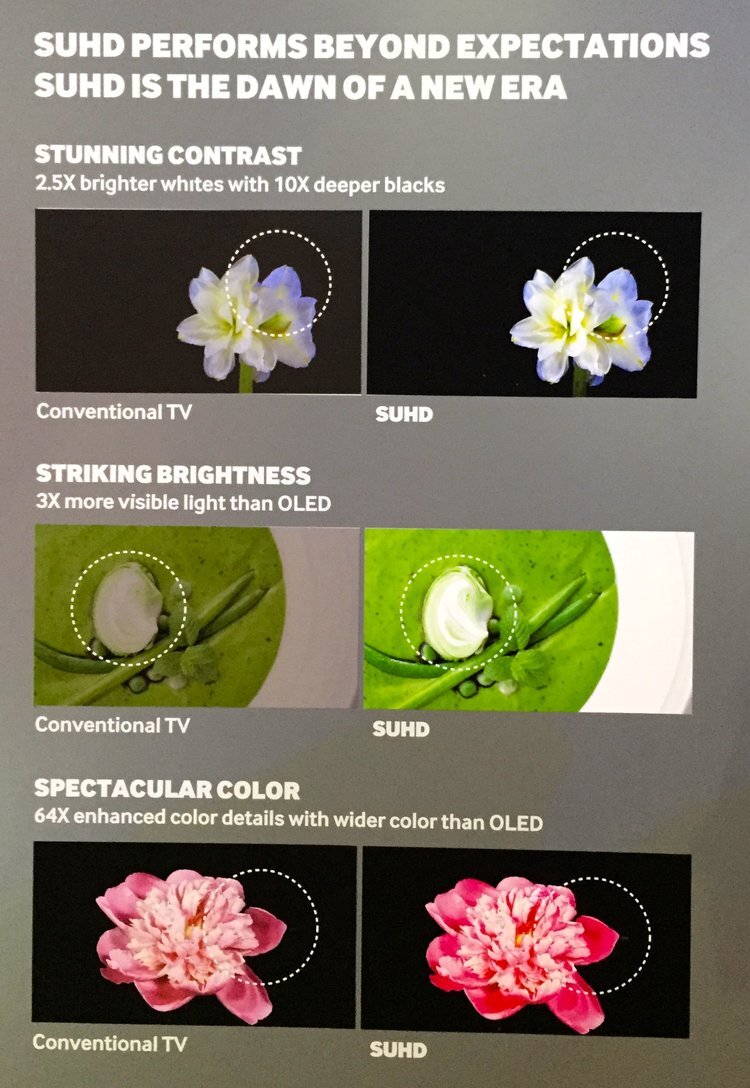CES 2015 Display wrap-up
Jan 13, 2015
Author: Jeff Yurek
Samsung SUHD Quantum Dot TVs at CES 2015
For each of the past six years, I’ve spent the second week in January immersed in all things consumer electronics at the legendary CES trade show in Las Vegas. Each year there’s a theme or buzzword that seems to grip the show, resonating from the convention center through all the meeting rooms at hotels up and down the strip. In the time I’ve been going, it’s been everything from 3D to pre-iPad tablets to wearables. This year, for the first time in a long while, it was all about TV and the message from the major brands was focused on bringing UHD to life with better pixels. Talk of improved color gamuts, high dynamic range and technologies like Quantum Dots ruled the show.
These were my top three display takeaways from CES 2015:
4K became passé before it ever hit the mainstream
There was a real sense from the big TV brands at CES that 4K resolution has reached entitlement status, that they’ve already moved on to the next big thing in image quality and 4K is now just so last year. This attitude seems a little crazy in a world where 4K TVs only make up a small part of the overall market and optimized content is only just becoming available. But it actually shows that these guys have done their homework- the 4K sets we saw last year were just the first step towards supporting the full Ultra HD broadcast spec.
UltraHD (UHD) is really about delivering not just more but better pixels to our TVs. 4K resolution is only one component of a new broadcast specification that will bring us images with richer, more accurate color, higher dynamic range and higher frame rates. Taken together, these features produce incredibly lifelike images and we’ve just started to see that vision coming together for the first time with the sets announced at CES this year.
Quantum Dot TVs are here
Samsung claims Quantum Dot based SUHD displays outperform OLED in brightness and color at CES 2015
I counted seven TV makers who announced new models based on Quantum Dot technology at CES- up from just one last year. Marketed by Samsung as a leap beyond OLED in image quality, it’s a big moment for a technology that’s been emerging for the past couple of years and could mark the beginning of an inflection year.
The most impressive Quantum Dot demonstrations could be found at the Samsung and Hisense booths. Both companies used the high brightness and color purity of Quantum Dots to blow away dimmer OLEDs in “Pepsi Challenge” style display shootouts. It will be interesting to see how this plays out with consumers in the Best Buy showroom this year.
4K, rec.2020 and HDR content is on the way
Quantum Dots, wider color gamut, high dynamic range, 4K resolution… together these features do represent a major leap forward in overall image quality. But there’s a catch: you’ll want optimized content to take advantage of all that those features have to offer and, so far, there hasn’t been a lot to pick from. It looks like that’s about to change based on two big announcements at CES.
First up, a number of content ecosystem players from creators to distribution to display including Warner Bros, Netflix and Samsung all joined forces to create what they are calling the UHD Alliance. Their purpose is to clarify the use of the term “UHD” and also to develop standards that will make it easy for consumers to access optimized content via the internet. If the wide color gamut/HDR optimized “Life of Pi” footage Samsung was showing on their SUHD TVs is any indication of what this new content will look like, this could work out well.
Panasonic also announced the first truly UHD Blu-ray disc player. The new format supports rec.2020 color gamut and HDR along with UHD resolution. This means consumers will be able to access fantastic looking full UHD content without needing a superfast internet connection.


